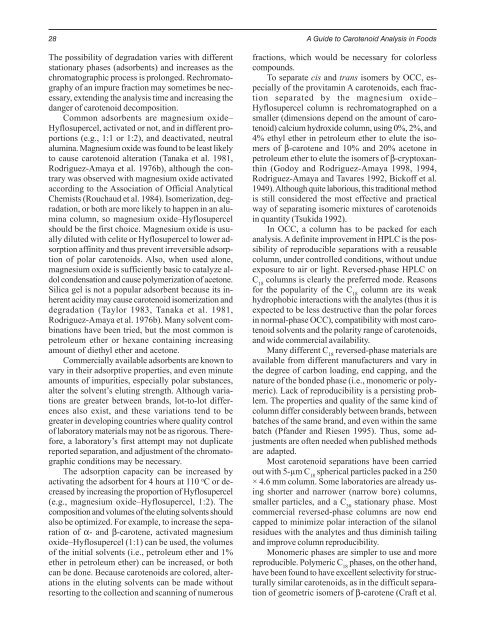A GUIDE TO CAROTENOID ANALYSIS IN FOODS
A GUIDE TO CAROTENOID ANALYSIS IN FOODS
A GUIDE TO CAROTENOID ANALYSIS IN FOODS
You also want an ePaper? Increase the reach of your titles
YUMPU automatically turns print PDFs into web optimized ePapers that Google loves.
28 A Guide to Carotenoid Analysis in Foods<br />
The possibility of degradation varies with different<br />
stationary phases (adsorbents) and increases as the<br />
chromatographic process is prolonged. Rechromatography<br />
of an impure fraction may sometimes be necessary,<br />
extending the analysis time and increasing the<br />
danger of carotenoid decomposition.<br />
Common adsorbents are magnesium oxide–<br />
Hyflosupercel, activated or not, and in different proportions<br />
(e.g., 1:1 or 1:2), and deactivated, neutral<br />
alumina. Magnesium oxide was found to be least likely<br />
to cause carotenoid alteration (Tanaka et al. 1981,<br />
Rodriguez-Amaya et al. 1976b), although the contrary<br />
was observed with magnesium oxide activated<br />
according to the Association of Official Analytical<br />
Chemists (Rouchaud et al. 1984). Isomerization, degradation,<br />
or both are more likely to happen in an alumina<br />
column, so magnesium oxide–Hyflosupercel<br />
should be the first choice. Magnesium oxide is usually<br />
diluted with celite or Hyflosupercel to lower adsorption<br />
affinity and thus prevent irreversible adsorption<br />
of polar carotenoids. Also, when used alone,<br />
magnesium oxide is sufficiently basic to catalyze aldol<br />
condensation and cause polymerization of acetone.<br />
Silica gel is not a popular adsorbent because its inherent<br />
acidity may cause carotenoid isomerization and<br />
degradation (Taylor 1983, Tanaka et al. 1981,<br />
Rodriguez-Amaya et al. 1976b). Many solvent combinations<br />
have been tried, but the most common is<br />
petroleum ether or hexane containing increasing<br />
amount of diethyl ether and acetone.<br />
Commercially available adsorbents are known to<br />
vary in their adsorptive properties, and even minute<br />
amounts of impurities, especially polar substances,<br />
alter the solvent’s eluting strength. Although variations<br />
are greater between brands, lot-to-lot differences<br />
also exist, and these variations tend to be<br />
greater in developing countries where quality control<br />
of laboratory materials may not be as rigorous. Therefore,<br />
a laboratory’s first attempt may not duplicate<br />
reported separation, and adjustment of the chromatographic<br />
conditions may be necessary.<br />
The adsorption capacity can be increased by<br />
activating the adsorbent for 4 hours at 110 o C or decreased<br />
by increasing the proportion of Hyflosupercel<br />
(e.g., magnesium oxide–Hyflosupercel, 1:2). The<br />
composition and volumes of the eluting solvents should<br />
also be optimized. For example, to increase the separation<br />
of α- and β-carotene, activated magnesium<br />
oxide–Hyflosupercel (1:1) can be used, the volumes<br />
of the initial solvents (i.e., petroleum ether and 1%<br />
ether in petroleum ether) can be increased, or both<br />
can be done. Because carotenoids are colored, alterations<br />
in the eluting solvents can be made without<br />
resorting to the collection and scanning of numerous<br />
fractions, which would be necessary for colorless<br />
compounds.<br />
To separate cis and trans isomers by OCC, especially<br />
of the provitamin A carotenoids, each fraction<br />
separated by the magnesium oxide–<br />
Hyflosupercel column is rechromatographed on a<br />
smaller (dimensions depend on the amount of carotenoid)<br />
calcium hydroxide column, using 0%, 2%, and<br />
4% ethyl ether in petroleum ether to elute the isomers<br />
of β-carotene and 10% and 20% acetone in<br />
petroleum ether to elute the isomers of β-cryptoxanthin<br />
(Godoy and Rodriguez-Amaya 1998, 1994,<br />
Rodriguez-Amaya and Tavares 1992, Bickoff et al.<br />
1949). Although quite laborious, this traditional method<br />
is still considered the most effective and practical<br />
way of separating isomeric mixtures of carotenoids<br />
in quantity (Tsukida 1992).<br />
In OCC, a column has to be packed for each<br />
analysis. A definite improvement in HPLC is the possibility<br />
of reproducible separations with a reusable<br />
column, under controlled conditions, without undue<br />
exposure to air or light. Reversed-phase HPLC on<br />
C 18 columns is clearly the preferred mode. Reasons<br />
for the popularity of the C 18 column are its weak<br />
hydrophobic interactions with the analytes (thus it is<br />
expected to be less destructive than the polar forces<br />
in normal-phase OCC), compatibility with most carotenoid<br />
solvents and the polarity range of carotenoids,<br />
and wide commercial availability.<br />
Many different C 18 reversed-phase materials are<br />
available from different manufacturers and vary in<br />
the degree of carbon loading, end capping, and the<br />
nature of the bonded phase (i.e., monomeric or polymeric).<br />
Lack of reproducibility is a persisting problem.<br />
The properties and quality of the same kind of<br />
column differ considerably between brands, between<br />
batches of the same brand, and even within the same<br />
batch (Pfander and Riesen 1995). Thus, some adjustments<br />
are often needed when published methods<br />
are adapted.<br />
Most carotenoid separations have been carried<br />
out with 5-µm C 18 spherical particles packed in a 250<br />
× 4.6 mm column. Some laboratories are already using<br />
shorter and narrower (narrow bore) columns,<br />
smaller particles, and a C 30 stationary phase. Most<br />
commercial reversed-phase columns are now end<br />
capped to minimize polar interaction of the silanol<br />
residues with the analytes and thus diminish tailing<br />
and improve column reproducibility.<br />
Monomeric phases are simpler to use and more<br />
reproducible. Polymeric C 18 phases, on the other hand,<br />
have been found to have excellent selectivity for structurally<br />
similar carotenoids, as in the difficult separation<br />
of geometric isomers of β-carotene (Craft et al.

















